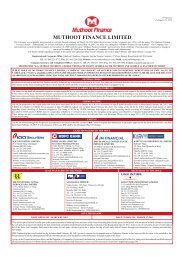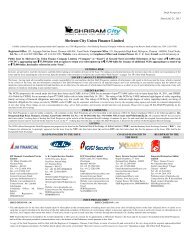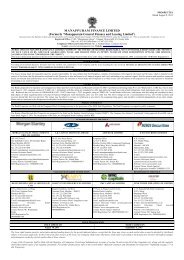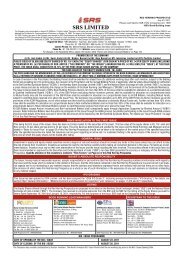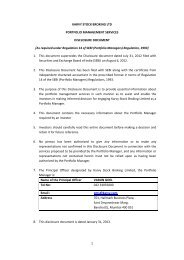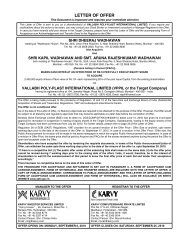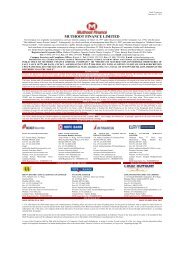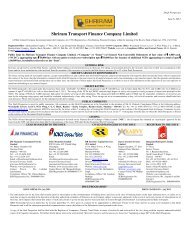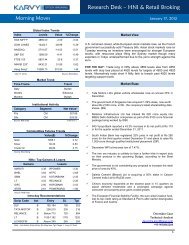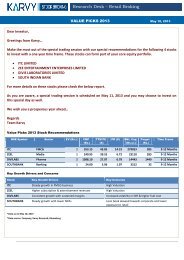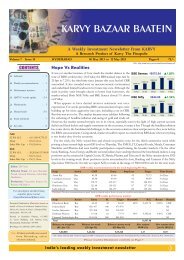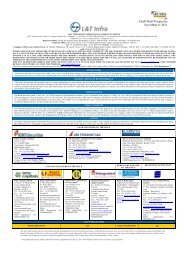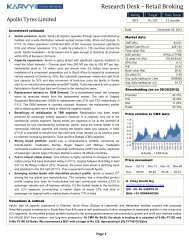APR Constructions Limited - Saffron Capital
APR Constructions Limited - Saffron Capital
APR Constructions Limited - Saffron Capital
Create successful ePaper yourself
Turn your PDF publications into a flip-book with our unique Google optimized e-Paper software.
The Indian Railways has been provided Rs 16,752 crore in 2010-11 for modernization and expansion of rail<br />
network.<br />
(Source: www.indiabudget.nic.in)<br />
TYPES OF CONTRACTS USED IN THE INFRASTRUCTURE AND CONSTRUCTION INDUSTRIES<br />
There are different models currently being adopted for Public Private Partnerships in India which vary in the<br />
distribution of risks and responsibility between the public and the private sectors for financing, constructing,<br />
operating, and maintaining projects. Two important types of contracts - BOT and BOOT - are explained below, as<br />
well as certain other contracts generally used in the Indian construction industry.<br />
Build, Operate and Transfer (“BOT”)<br />
Under this type of PPP contract, the Government grants to a contractor a concession to finance, build, operate and<br />
maintain a facility for a concession period. During the life of the concession, the operator collects user fees and<br />
applies these to cover the costs of construction, debt-servicing and operations. At the end of the concession period, the<br />
facility is transferred back to the public authority. BOT is the most commonly used approach in relation to new<br />
highway projects in India, and is also used in the energy and port sectors.<br />
Build, Own, Operate and Transfer (“BOOT”)<br />
BOOT contracts are similar to BOT contracts, except that in this case the contractor owns the underlying asset,<br />
instead of only owning a concession to operate the asset. For example, in the case of hydroelectric power projects, the<br />
contractor would own the asset during the underlying concession period and the asset would be transferred to the<br />
Government at the end of that period pursuant to the terms of the concession agreement.<br />
Design, Build, Finance and Operate (“DBFO”)<br />
The NHAI is planning to award new highway contracts under the DBFO scheme, wherein the detailed design work is<br />
done by the concessionaire. The NHAI would restrict itself to setting out the exact requirements in terms of quality<br />
and other structure of the road, and the design of the roads will be at the discretion of the concessionaire. The DBFO<br />
scheme will improve the design efficiency, reduce the cost of construction and reduce time to commence operations,<br />
in addition to giving the concessionaire greater flexibility in terms of determining the finer details of the project in the<br />
most efficient manner.<br />
Item Rate Contracts<br />
These contracts are also known as unit-price contracts or schedule contracts. For item rate contracts, contractors are<br />
required to quote rates for individual items of work on the basis of a schedule of quantities furnished by the customer.<br />
The design and drawings are provided by the customer. The contractor bears almost no risk in these contracts, except<br />
escalation in the rates of items quoted by the contractor, as it is paid according to the actual amount of work on the<br />
basis of the per-unit price quoted.<br />
Engineering Procurement Construction/Lump-Sum Turnkey Contracts<br />
In this form of contract, contractors are required to quote a fixed sum for the execution of an entire project including<br />
design, engineering and execution in accordance with drawings, designs and specifications submitted by the<br />
contractor and approved by the customer. The contractor bears the risk of incorrect estimation of the amount of work,<br />
materials or time required for the job. Escalation clauses might exist in some cases to cover, at least partially, cost<br />
overruns.<br />
78



